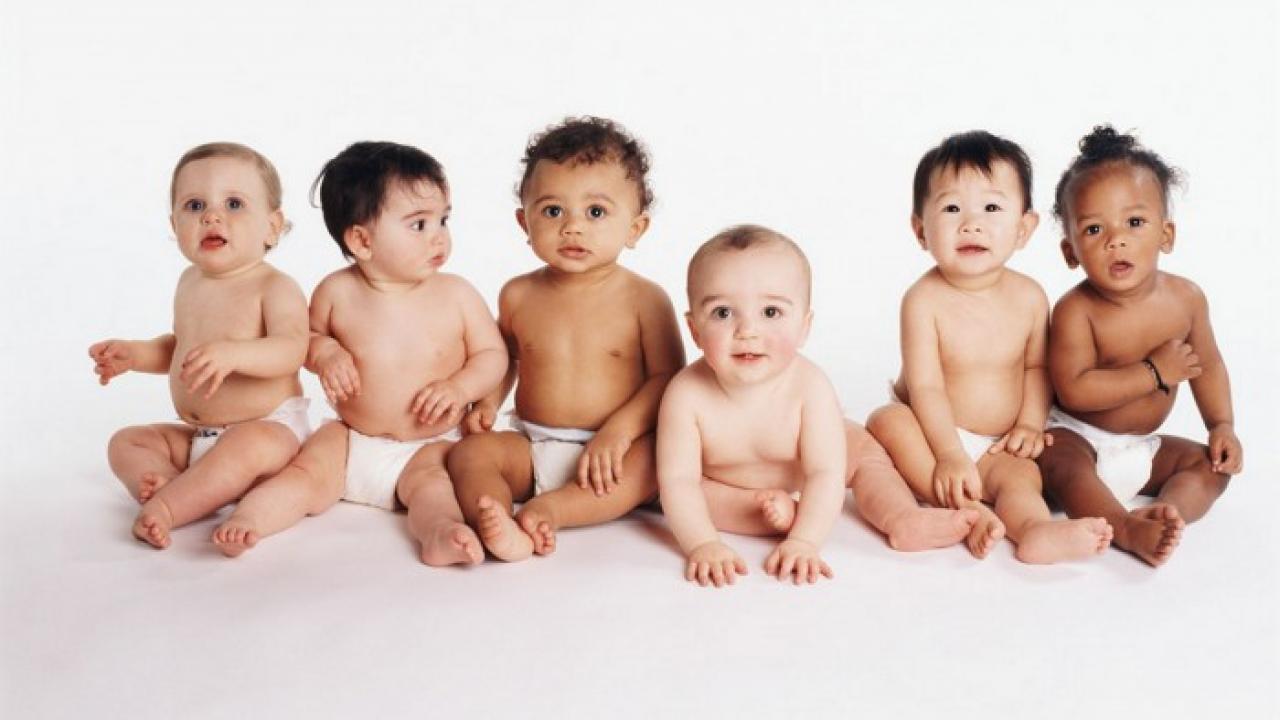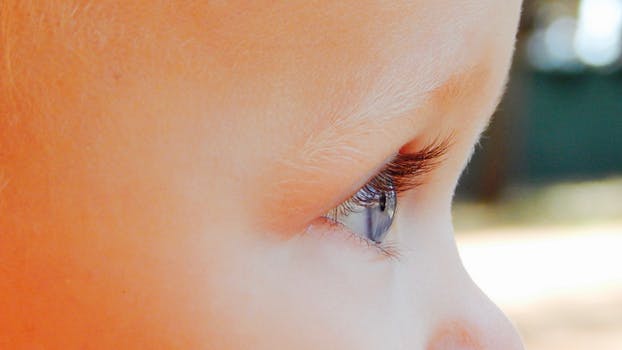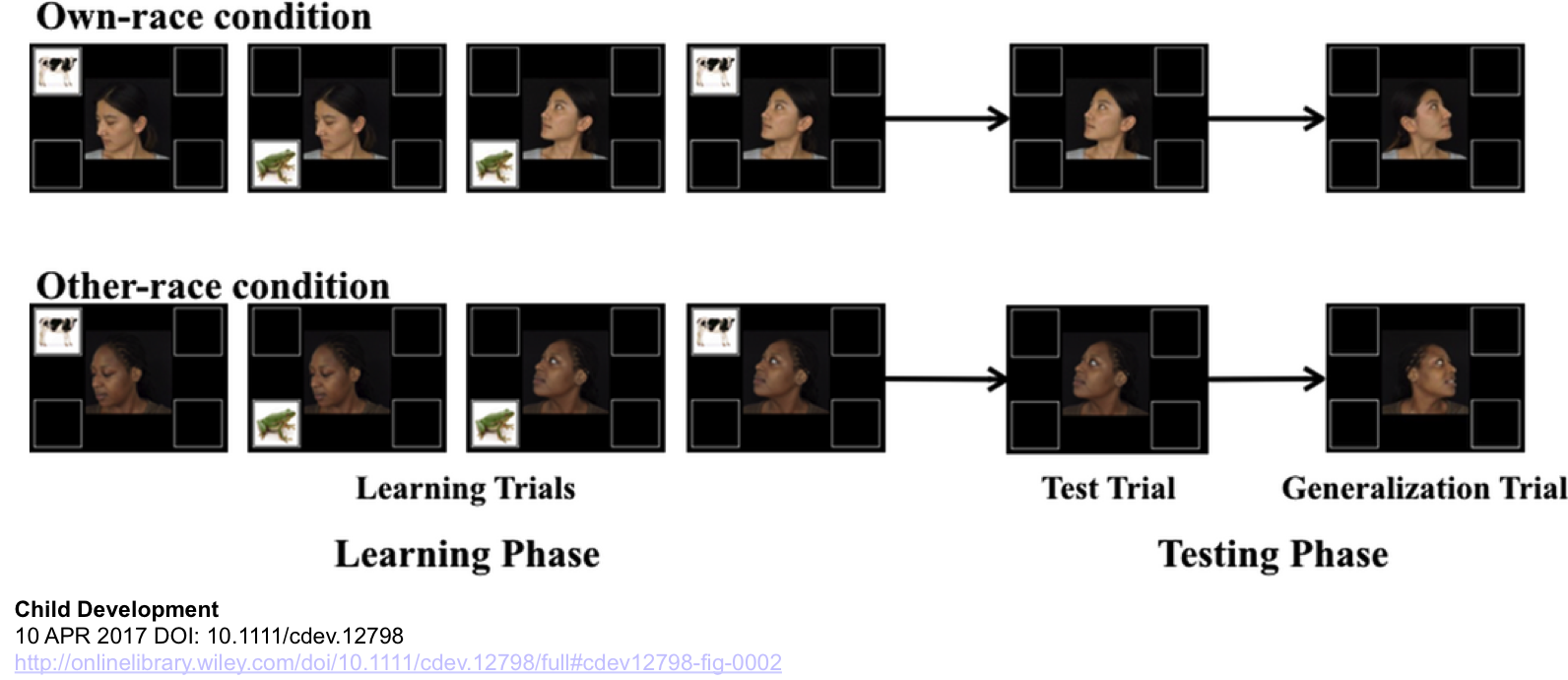
No, your baby is not racist.
Babies are terrible at a lot of things. They're terrible at walking, they puke all over, cry at the worst times, and stare at people in the grocery store. No social etiquette whatsoever. But, contrary to recent media claims, they are not racist.
Saying that a baby can be racist misunderstands racism and child development. So, what's with the headlines dogging on the youngest members of our society? We have this fascination (exhibit A, exhibit B) with attributing adult motivations and personality traits to babies. But babies aren't just miniature adults.

The science behind these racist babies headlines is much less terrible and much more interesting. Two recent studies from a group of child development researchers led by Dr. Lee Kang at the University of Toronto looked at how babies view race.
In the first, Dr. Kang's group tested whether babies preferentially follow the gaze of a same-race woman or a different-race woman in a game of animal picture pop-up. The researchers began with a learning phase (see the figure below). During this learning phase, the woman always, never, or only sometimes looked at the animal picture. This would teach a baby whether the actress was reliable.

After going through the learning phase, the babies were given a test trial (the actual experiment). This is when the researchers watched whether or not the baby followed the gaze of the woman before the animal popped up.
The results are what you might expect: the babies followed the gaze of the familiar/similar looking woman (of the same race) more often than a different-race woman. But this was only the case when the women-gazers were only somewhat reliable. If the gaze of either woman predicted the location of the animal 100% of the time, the baby would follow the women's eyeline equally as often regardless of race. Conversely, when each woman's gaze was completely unreliable in indicating the location of the animal on the screen, the baby would follow neither.
This showed a couple things. First, babies weigh reliability by picking up patterns from which they then make decisions. In this case, these initial patterns are in the learning phase. The babies in this experiment were able to pick up on whether or not the women were reliable in predicting the animal pop-up and then decide to follow or not follow their gaze in the test trial. Second, the experiment showed that babies discern differences in facial characteristics. The more familiar a baby is with certain facial characteristics the more likely they will follow cues from those people in uncertain situations.
"Babies discern differences in facial characteristics."
In the second experiment, Dr. Kang and colleagues recorded how long each baby looked at pictures of different and similar-race adult faces as they listened to either happy or sad music. One of the most interesting findings of this experiment was the difference in response depending on the baby's age. Older infants (9 months old versus 3-6 months old) were more likely to gaze at same race faces when paired with happy music and different race faces with the sad music.
The results of these studies point to a tendency of babies of a certain age to have preference for same-race faces, indicative of racial bias. Dr. Kang however, clarified that by saying that infants are racially biased we mean that infants show a tendency to favor the individuals of one race over those of another emotionally or behaviorally, just like their strong preference for female adults over male adults, attractive adults over unattractive adults, adults speaking the native language over adults speaking non-native language, or even familiar adults over strangers.
It would be interesting in the future to study the preferences of babies adopted by different-race families. This would allow scientists to determine if adopted babies prefer faces similar to their families or faces of their own ethnicity. This also raises interesting questions about when in developmental time babies start to conceptualize their own ethnicity by recognizing and comparing physical characteristics of other people.

What is immediately clear is that babies integrate multiple types of information from their environment (the faces they see, the voices they hear, the genders they interact with, etc.). In scientific terms, preference for one race over another is racial bias. However, it's important to make the distinction between racial bias in the scientific sense, and racism.
Babies notice physical traits in others and test the patterns they create. This racial bias can be clearly contrasted with what we think of as racism, which Dr. Kang explains as when an individual displays overtly negative attitudes towards people from another race group, subscribes overt stereotypes about them, and most importantly, discriminates against them in action.
So what does it mean if your baby is racially biased? This shouldn't be a cause for alarm...just yet. Of course, as Dr. Kang mentions, the most important question is whether such early bias will grow into the overt form of racism in adulthood. We don't know the full answer to this question since more work needs to be done to make these direct connections, but it's something Dr. Kang and his colleagues are actively interested in and aim to explore in the future.
"Exposure to a diversity of races reduces implicit bias."
What we can say is that these results lend a lot of weight to the role of environment on a child's social development. A baby's world during the first year of life is typically populated with same-race individuals. There is genuine concern that biases based on unfamiliarity, however innocent, could develop into unfair stereotypes. Dr. Kang suggests that parents consider introducing their infants and children to books, people, and TV programs that depict other-race individuals as individuals, not as a group. The impact of diversity on a child's social development has been explored by Kang as well as other research groups, all of which conclude that exposure to a diversity of races reduces implicit bias in children and improves their ability to distinguish personal characteristics in other race individuals.
So, babies aren't racist, they just act based on the familiar. And in a world so big and confusing for a baby, can you blame them? While it must've been tempting to write headlines calling babies bigots (maybe it's the alliteration), that's not what the studies aimed to test nor what they concluded. What the "racist babies" articles meant to say was that babies show preference for faces that look like theirs. And while it's alarming to imagine that a fully-formed, socially present (and utterly shameless) person is sizing us up from the crib, babies are probably too busy trying to figure out the world around them to judge you based on your ethnicity.
Destiny Davis (author) and Sam Tucci (editor) are graduate students at the University of California in Davis. This post was written as part of a project called "Science REALLY says" which seeks to ensure scientific data is accurately represented by the media. For more content from the UC Davis science communication group "Science Says" follow us on twitter @SciSays and like us on facebook.
Acknowledgements
We thank Dr. Lee Kang (Professor of Applied Psychology and Human Development at the University of Toronto)Â for helpful comments.
References (*main studies discussed)
*Xiao, N.G., Wu, R., Quinn, P.C., Liu, S., Tummeltshammer, K.S., Kirkham, N.Z., Ge, L., Pascalis, O., Lee, K. (2017). Infants Rely More on Gaze Cues From Own-Race Than Other-Race Adults for Learning Under Uncertainty. Child Development. http://doi.org/10.1111/cdev.12798 *Xiao, N.G., Quinn, P.C., Liu, S., Ge, L., Pascalis, O., Lee, K. (2017). Older but not younger infants associate own-race faces with happy music and other-race faces with sad music. Developmental Science. http://doi.org/10.1111/desc.12537 Xiao, W.S., Fu, G., Quinn, P.C>, Qin, J., Tanaka, J.W., Pascalis, O., Lee, K.(2015). Individuation training with other-race faces reduces preschoolers' implicit racial bias: a link between perceptual and social representation of faces in children. Developmental Science. https://doi.org/10.1111/desc.12241 Anzures, G., Quinn, P.C., Pascalis, O., Slater, A.M., Lee, K. (2010). Categorization, categorial perception, and asymmetry in infants' representation of face race. Developmental Science. https://doi.org/10.1111/j.1467-7687.2009.00900.x. Anzures, G., Wheeler, A., Quinn, P.C., Pascalis, O., Slater, A.M., Heron-Delaney, M., Tanaka, J.W., Lee, K. (2012). Brief daily exposures to Asian females reverses perceptual narrowing for Asian faces in Caucasian infants. Journal of Experimental Child Psychology. https://doi.org/10.1016/j.jecp.2012.04.005 Bar-Haim, Y., Ziv, T., Lamy, D., Hodes, R.M. (2006) Nature and Nurture in Own-Race Face Processing. Psychological Science. http://journals.sagepub.com/doi/abs/10.1111/j.1467-9280.2006.01679.x Heron-Delaney, M., Anzures, G., Herbert, J.S., Quinn, P.C., Slater, A.M., Tanaka, J.W., Lee, K., Pascalis, O. (2011). Perceptual Training Prevents the Emergence of the Other Race Effect during Infancy. PLoS One. https://doi.org/10.1371/journal.pone.0019858 Kelly, D.J., Quinn, P.C., Slater, A.M., Lee, K., Gibson, A., Smith, M., Ge, L., Pascalis, O. (2005). Three-month-olds, but not newborns, prefer own-race faces. Developmental Science. https://doi.org/10.1111/j.1467-7687.2005.0434a.x

Comments